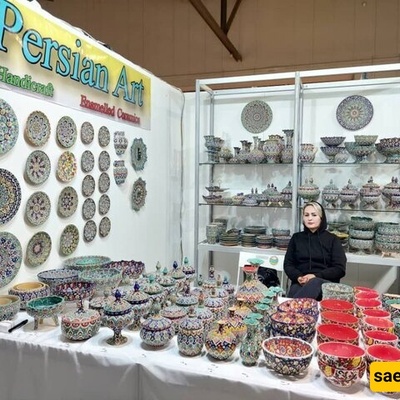Saed News: In Tehran, an ancient city, many palaces from past times have been preserved. These palaces were built by past kings as their residences and workplaces. These beautiful royal palaces, such as Golestan Palace and Saadabad Palace, are some of the most famous palaces from the Qajar and Pahlavi periods.

Tehran, a city steeped in history, is home to numerous palaces from the Qajar and Pahlavi periods. These magnificent royal residences, built for past kings, stand as testaments to Iran's rich history and royal heritage. Let’s take you on a tour of Tehran’s most famous palaces, each offering a glimpse into the grandeur of Iran’s past.
Nestled in the heart of Tehran near the bustling market, Golestan Palace is a masterpiece of colorful tiles and lush greenery, giving it a perpetual spring-like atmosphere. This historic site consists of several sections, including the Salam Hall, Marble Courtyard, Mirror Hall, and the iconic Shams ol-Emareh building.
Historical events like the wedding of Shah Mohammad Reza Pahlavi to Farah Diba and the Pahlavi coronation took place here.
Address: Tehran, 15 Khordad Street, North side of Arg Square, Golestan Palace

Although associated with the Pahlavi dynasty, Niavaran Palace’s foundation was laid by the Qajar dynasty. The last building added here, the Ahmad Shah Pavilion, was constructed during the Qajar era. The construction of the Niavaran Palace itself began in 1958 under Mohammad Reza Shah.
Though designed to host foreign dignitaries, it later became the royal residence. Niavaran Palace is renowned for its modern and minimalist architectural style, in contrast to other palaces in Iran.
Explore the palace’s private library, the Ahmad Shah Pavilion, the Royal Car Museum, the World Vision Museum, and the Sahebqaranieh Palace.
Address: Tehran, Shahid Bahonar Square (Niavaran), Niavaran Cultural and Historical Complex

Saadabad Palace is an expansive complex with 18 palaces from the Qajar and Pahlavi eras, set in a stunning natural environment. With towering trees and a river running through it, the complex offers a serene escape from the hustle and bustle of the city.
Visit the Green Palace (Reza Shah’s residence), the Nation Palace (Mohammad Reza Shah's residence), Shams Palace, the royal kitchen, and the museum of royal china, alongside exhibits showcasing Iranian art.
Address: Tehran, Tajrish Square, Shahid Jafari Street, Southern side of Darband Square, Saadabad Complex

Constructed in 1928, the Sultaniabad Palace was once a favorite summer retreat of Nasser al-Din Shah. However, much of the palace was demolished under Reza Shah’s orders. Today, only the Pool House, the Mirror Hall, and the Throne remain.
This palace is now used by the Ministry of Defense, so public visits are restricted.
Address: Tehran, Pasdaran Street, near Nowband Street, Sultaniabad Palace
Marble Palace, built by Reza Shah, stands as a symbol of the grandeur of the Pahlavi dynasty. The palace’s green marble columns that adorn its exterior give the palace its unique name. After the Revolution, it was used by the Committee for Revolution and later the Expediency Discernment Council. Today, it is open to the public as a museum showcasing Pahlavi artifacts.
Address: Tehran, Imam Khomeini Street, Vali Asr Street

Built in the style of the Trocadéro Palace in Paris, Farahabad Palace boasts a semicircular front with a surrounding terrace. Constructed during the Qajar era, it was later abandoned during the reign of Reza Shah. Today, the palace is under the control of the Islamic Revolutionary Guard Corps, and public visits are not permitted.
Address: Tehran, Abas Douran Highway, end of Peyrozi Street, Farahabad Palace
Yaghoot Palace, also known as the Serkhe Hesar Palace, was built in 1883 for Nasser al-Din Shah. Known for its stunning architecture and 200 rooms, it is now used as an administrative building for Lavasani Hospital. The palace is currently undergoing restoration with plans to transform it into a museum.
Address: Tehran, Serkhe Hesar, Near Shaheed Hemmat Highway, Lavasani Hospital
Constructed by Nasser al-Din Shah, this four-story palace was used for royal celebrations. It features a large pool surrounded by small houses, each given to one of the king’s wives. After the revolution, the Air Force took over, renaming it the Vali-Asr Military Base. In 2006, the palace was returned to the public, with plans for restoration underway.
Address: Tehran, Eshrat Abad Square, Vali-Asr Military Base

Built at the end of the Pahlavi era, the Khoram Palace is rumored to have hidden tunnels leading to Tehran University. Though it is now used as a parking lot for Rasool Akram Hospital, it remains an intriguing spot steeped in mystery.
Address: Tehran, Shahid Chamran Highway, Malakooti, Between Shahrara and Siamaki
Once the building of Iran’s Parliament, Sena Palace later became the place where the Iranian Constitution was written after the Revolution. It served as the headquarters for the Islamic Consultative Assembly until 2001.
Address: Tehran, Imam Khomeini Street, Opposite Imam Ali Military Academy, near Marble Palace

Built in 1961, the Sabet Pasal Palace was once one of Tehran’s most luxurious homes. It was inhabited by Habibollah Sabet, who lived there with his family for just two years before fleeing to the U.S. after the revolution. Today, the palace is a national heritage site and is not open to the public.
Address: Tehran, Near Beheshti Avenue, Sabet Pasal Palace

